A Comprehensive Report on Infection Control in UK Healthcare Settings
VerifiedAdded on 2023/01/10
|10
|3695
|44
Report
AI Summary
This report provides a critical analysis of infection control in UK hospitals, focusing on the importance of maintaining a clean environment to prevent the spread of infections, with a particular focus on the UK where a significant number of patients suffer from hospital-acquired infections. The report explores various factors contributing to this issue, including changes in policies, social trends, and environmental concerns, as well as legal and ethical considerations. It examines the practices and measures implemented to control infection, such as hand hygiene, the use of gloves and protective equipment, and sterilization of medical equipment. The report also discusses the debates surrounding infection control, including ethical dilemmas and the impact on patient outcomes and hospital reputation. The report emphasizes the need for effective strategies, proper training, and adherence to guidelines to mitigate risks and improve patient care. This report is a contribution to Desklib, a platform offering AI-based study tools for students.
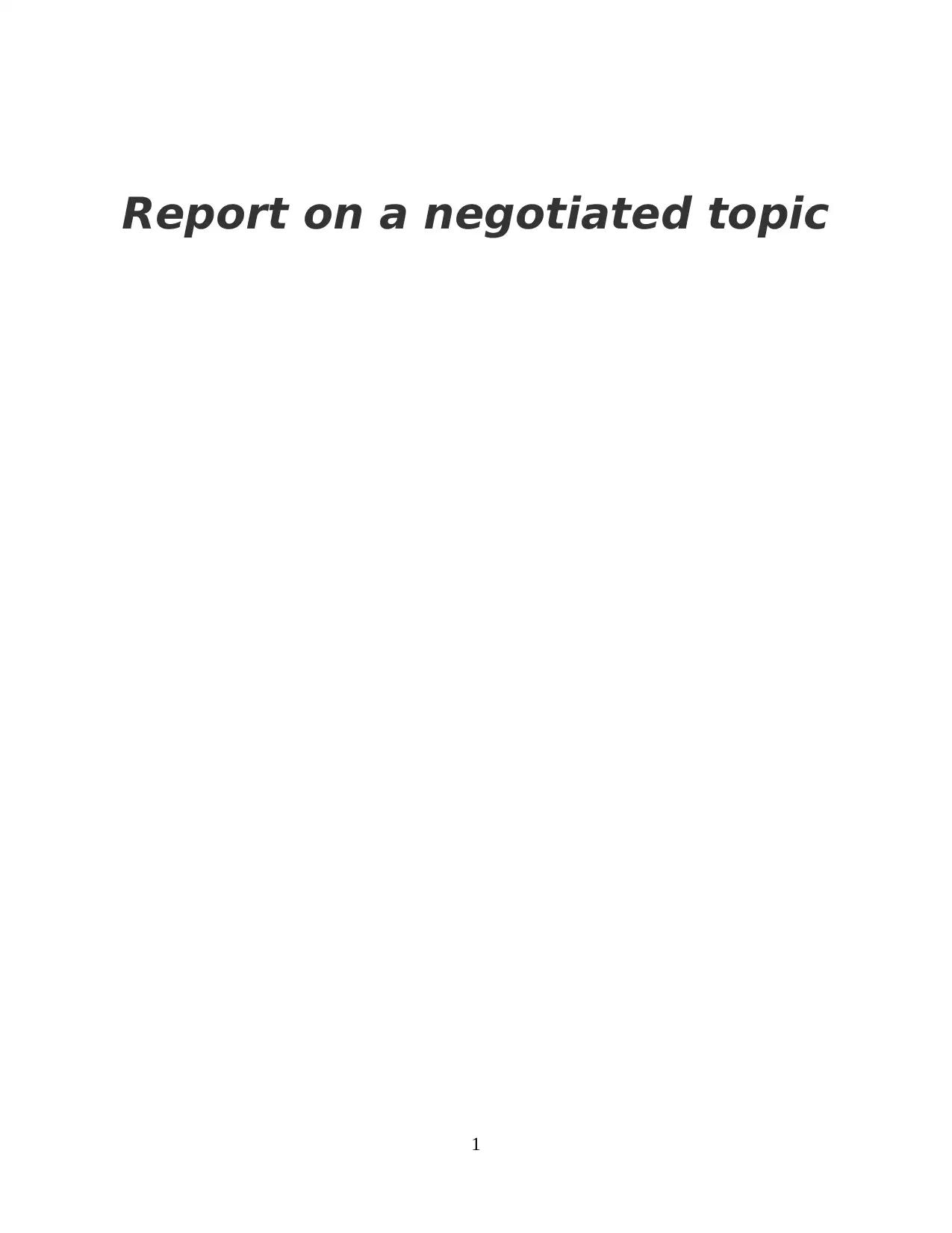
Report on a negotiated topic
1
1
Paraphrase This Document
Need a fresh take? Get an instant paraphrase of this document with our AI Paraphraser
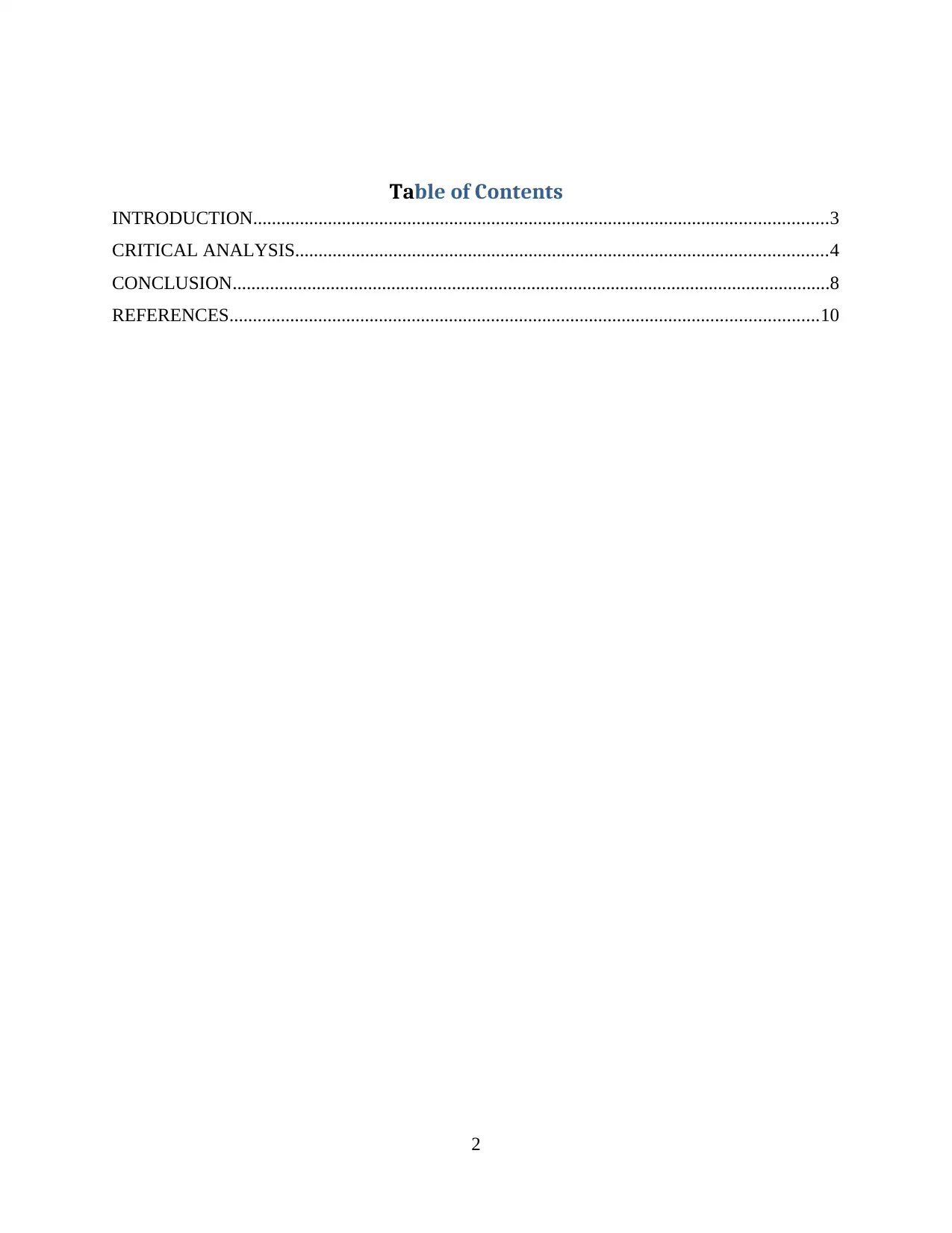
Table of Contents
INTRODUCTION...........................................................................................................................3
CRITICAL ANALYSIS..................................................................................................................4
CONCLUSION................................................................................................................................8
REFERENCES..............................................................................................................................10
2
INTRODUCTION...........................................................................................................................3
CRITICAL ANALYSIS..................................................................................................................4
CONCLUSION................................................................................................................................8
REFERENCES..............................................................................................................................10
2
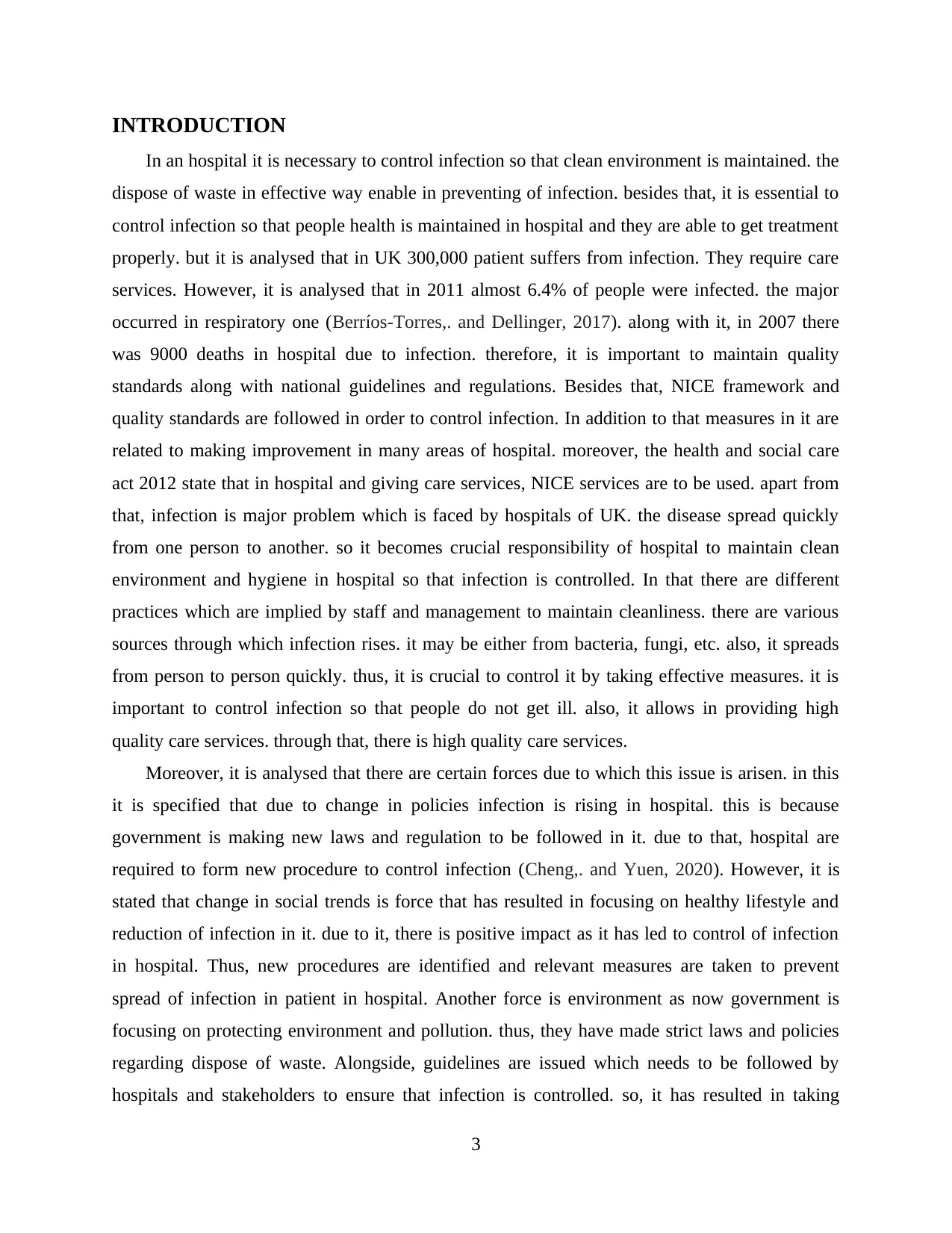
INTRODUCTION
In an hospital it is necessary to control infection so that clean environment is maintained. the
dispose of waste in effective way enable in preventing of infection. besides that, it is essential to
control infection so that people health is maintained in hospital and they are able to get treatment
properly. but it is analysed that in UK 300,000 patient suffers from infection. They require care
services. However, it is analysed that in 2011 almost 6.4% of people were infected. the major
occurred in respiratory one (Berríos-Torres,. and Dellinger, 2017). along with it, in 2007 there
was 9000 deaths in hospital due to infection. therefore, it is important to maintain quality
standards along with national guidelines and regulations. Besides that, NICE framework and
quality standards are followed in order to control infection. In addition to that measures in it are
related to making improvement in many areas of hospital. moreover, the health and social care
act 2012 state that in hospital and giving care services, NICE services are to be used. apart from
that, infection is major problem which is faced by hospitals of UK. the disease spread quickly
from one person to another. so it becomes crucial responsibility of hospital to maintain clean
environment and hygiene in hospital so that infection is controlled. In that there are different
practices which are implied by staff and management to maintain cleanliness. there are various
sources through which infection rises. it may be either from bacteria, fungi, etc. also, it spreads
from person to person quickly. thus, it is crucial to control it by taking effective measures. it is
important to control infection so that people do not get ill. also, it allows in providing high
quality care services. through that, there is high quality care services.
Moreover, it is analysed that there are certain forces due to which this issue is arisen. in this
it is specified that due to change in policies infection is rising in hospital. this is because
government is making new laws and regulation to be followed in it. due to that, hospital are
required to form new procedure to control infection (Cheng,. and Yuen, 2020). However, it is
stated that change in social trends is force that has resulted in focusing on healthy lifestyle and
reduction of infection in it. due to it, there is positive impact as it has led to control of infection
in hospital. Thus, new procedures are identified and relevant measures are taken to prevent
spread of infection in patient in hospital. Another force is environment as now government is
focusing on protecting environment and pollution. thus, they have made strict laws and policies
regarding dispose of waste. Alongside, guidelines are issued which needs to be followed by
hospitals and stakeholders to ensure that infection is controlled. so, it has resulted in taking
3
In an hospital it is necessary to control infection so that clean environment is maintained. the
dispose of waste in effective way enable in preventing of infection. besides that, it is essential to
control infection so that people health is maintained in hospital and they are able to get treatment
properly. but it is analysed that in UK 300,000 patient suffers from infection. They require care
services. However, it is analysed that in 2011 almost 6.4% of people were infected. the major
occurred in respiratory one (Berríos-Torres,. and Dellinger, 2017). along with it, in 2007 there
was 9000 deaths in hospital due to infection. therefore, it is important to maintain quality
standards along with national guidelines and regulations. Besides that, NICE framework and
quality standards are followed in order to control infection. In addition to that measures in it are
related to making improvement in many areas of hospital. moreover, the health and social care
act 2012 state that in hospital and giving care services, NICE services are to be used. apart from
that, infection is major problem which is faced by hospitals of UK. the disease spread quickly
from one person to another. so it becomes crucial responsibility of hospital to maintain clean
environment and hygiene in hospital so that infection is controlled. In that there are different
practices which are implied by staff and management to maintain cleanliness. there are various
sources through which infection rises. it may be either from bacteria, fungi, etc. also, it spreads
from person to person quickly. thus, it is crucial to control it by taking effective measures. it is
important to control infection so that people do not get ill. also, it allows in providing high
quality care services. through that, there is high quality care services.
Moreover, it is analysed that there are certain forces due to which this issue is arisen. in this
it is specified that due to change in policies infection is rising in hospital. this is because
government is making new laws and regulation to be followed in it. due to that, hospital are
required to form new procedure to control infection (Cheng,. and Yuen, 2020). However, it is
stated that change in social trends is force that has resulted in focusing on healthy lifestyle and
reduction of infection in it. due to it, there is positive impact as it has led to control of infection
in hospital. Thus, new procedures are identified and relevant measures are taken to prevent
spread of infection in patient in hospital. Another force is environment as now government is
focusing on protecting environment and pollution. thus, they have made strict laws and policies
regarding dispose of waste. Alongside, guidelines are issued which needs to be followed by
hospitals and stakeholders to ensure that infection is controlled. so, it has resulted in taking
3
⊘ This is a preview!⊘
Do you want full access?
Subscribe today to unlock all pages.

Trusted by 1+ million students worldwide
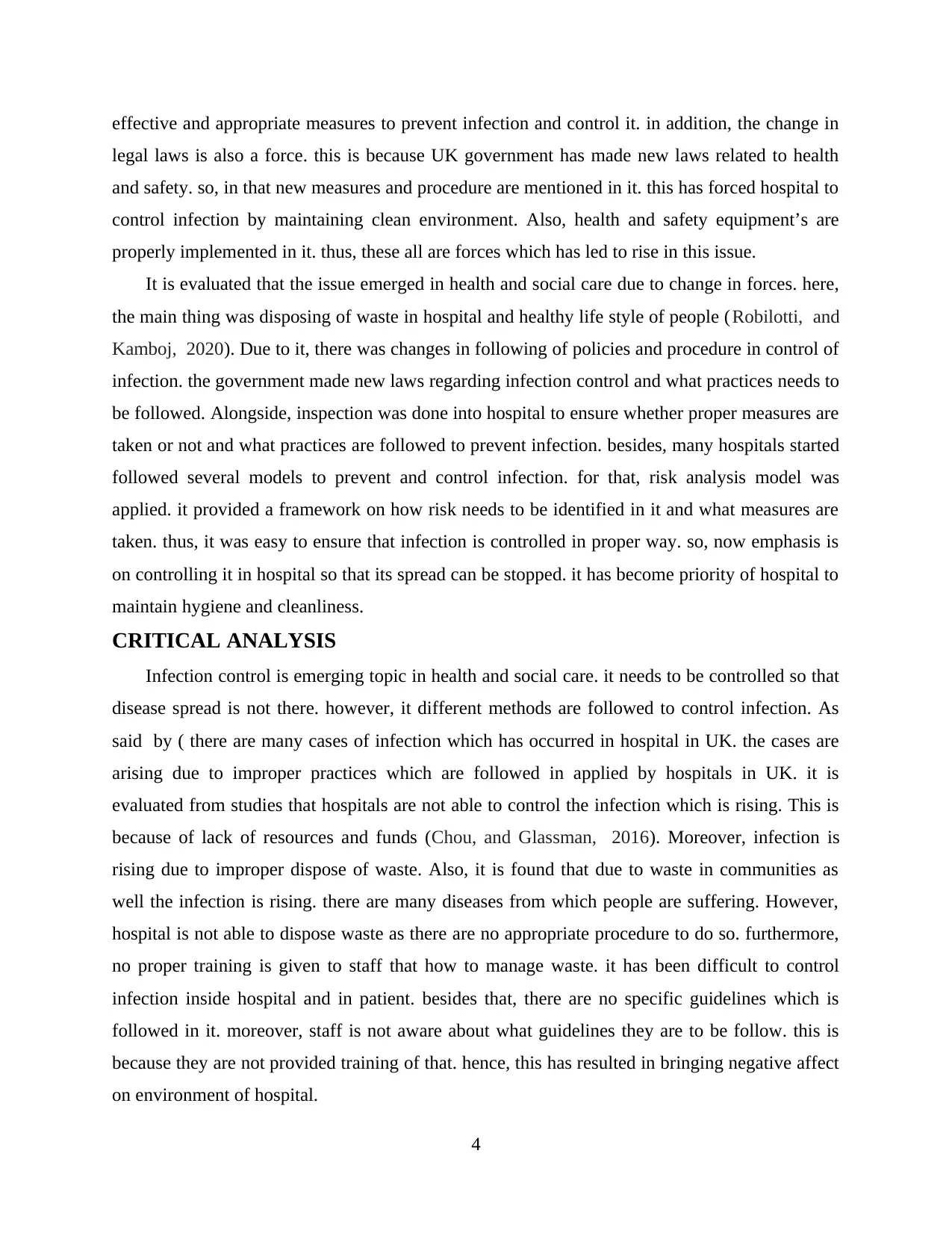
effective and appropriate measures to prevent infection and control it. in addition, the change in
legal laws is also a force. this is because UK government has made new laws related to health
and safety. so, in that new measures and procedure are mentioned in it. this has forced hospital to
control infection by maintaining clean environment. Also, health and safety equipment’s are
properly implemented in it. thus, these all are forces which has led to rise in this issue.
It is evaluated that the issue emerged in health and social care due to change in forces. here,
the main thing was disposing of waste in hospital and healthy life style of people (Robilotti, and
Kamboj, 2020). Due to it, there was changes in following of policies and procedure in control of
infection. the government made new laws regarding infection control and what practices needs to
be followed. Alongside, inspection was done into hospital to ensure whether proper measures are
taken or not and what practices are followed to prevent infection. besides, many hospitals started
followed several models to prevent and control infection. for that, risk analysis model was
applied. it provided a framework on how risk needs to be identified in it and what measures are
taken. thus, it was easy to ensure that infection is controlled in proper way. so, now emphasis is
on controlling it in hospital so that its spread can be stopped. it has become priority of hospital to
maintain hygiene and cleanliness.
CRITICAL ANALYSIS
Infection control is emerging topic in health and social care. it needs to be controlled so that
disease spread is not there. however, it different methods are followed to control infection. As
said by ( there are many cases of infection which has occurred in hospital in UK. the cases are
arising due to improper practices which are followed in applied by hospitals in UK. it is
evaluated from studies that hospitals are not able to control the infection which is rising. This is
because of lack of resources and funds (Chou, and Glassman, 2016). Moreover, infection is
rising due to improper dispose of waste. Also, it is found that due to waste in communities as
well the infection is rising. there are many diseases from which people are suffering. However,
hospital is not able to dispose waste as there are no appropriate procedure to do so. furthermore,
no proper training is given to staff that how to manage waste. it has been difficult to control
infection inside hospital and in patient. besides that, there are no specific guidelines which is
followed in it. moreover, staff is not aware about what guidelines they are to be follow. this is
because they are not provided training of that. hence, this has resulted in bringing negative affect
on environment of hospital.
4
legal laws is also a force. this is because UK government has made new laws related to health
and safety. so, in that new measures and procedure are mentioned in it. this has forced hospital to
control infection by maintaining clean environment. Also, health and safety equipment’s are
properly implemented in it. thus, these all are forces which has led to rise in this issue.
It is evaluated that the issue emerged in health and social care due to change in forces. here,
the main thing was disposing of waste in hospital and healthy life style of people (Robilotti, and
Kamboj, 2020). Due to it, there was changes in following of policies and procedure in control of
infection. the government made new laws regarding infection control and what practices needs to
be followed. Alongside, inspection was done into hospital to ensure whether proper measures are
taken or not and what practices are followed to prevent infection. besides, many hospitals started
followed several models to prevent and control infection. for that, risk analysis model was
applied. it provided a framework on how risk needs to be identified in it and what measures are
taken. thus, it was easy to ensure that infection is controlled in proper way. so, now emphasis is
on controlling it in hospital so that its spread can be stopped. it has become priority of hospital to
maintain hygiene and cleanliness.
CRITICAL ANALYSIS
Infection control is emerging topic in health and social care. it needs to be controlled so that
disease spread is not there. however, it different methods are followed to control infection. As
said by ( there are many cases of infection which has occurred in hospital in UK. the cases are
arising due to improper practices which are followed in applied by hospitals in UK. it is
evaluated from studies that hospitals are not able to control the infection which is rising. This is
because of lack of resources and funds (Chou, and Glassman, 2016). Moreover, infection is
rising due to improper dispose of waste. Also, it is found that due to waste in communities as
well the infection is rising. there are many diseases from which people are suffering. However,
hospital is not able to dispose waste as there are no appropriate procedure to do so. furthermore,
no proper training is given to staff that how to manage waste. it has been difficult to control
infection inside hospital and in patient. besides that, there are no specific guidelines which is
followed in it. moreover, staff is not aware about what guidelines they are to be follow. this is
because they are not provided training of that. hence, this has resulted in bringing negative affect
on environment of hospital.
4
Paraphrase This Document
Need a fresh take? Get an instant paraphrase of this document with our AI Paraphraser
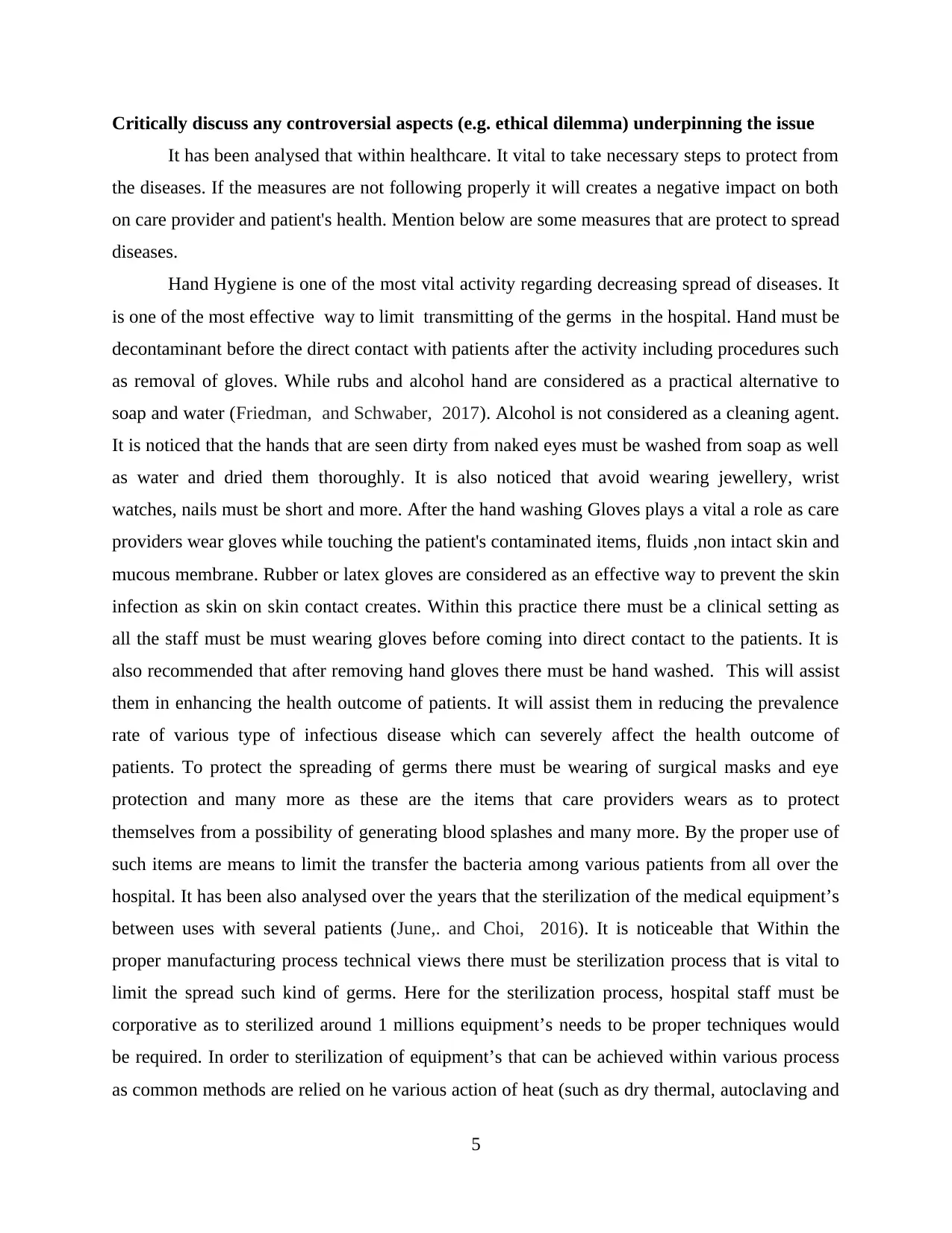
Critically discuss any controversial aspects (e.g. ethical dilemma) underpinning the issue
It has been analysed that within healthcare. It vital to take necessary steps to protect from
the diseases. If the measures are not following properly it will creates a negative impact on both
on care provider and patient's health. Mention below are some measures that are protect to spread
diseases.
Hand Hygiene is one of the most vital activity regarding decreasing spread of diseases. It
is one of the most effective way to limit transmitting of the germs in the hospital. Hand must be
decontaminant before the direct contact with patients after the activity including procedures such
as removal of gloves. While rubs and alcohol hand are considered as a practical alternative to
soap and water (Friedman, and Schwaber, 2017). Alcohol is not considered as a cleaning agent.
It is noticed that the hands that are seen dirty from naked eyes must be washed from soap as well
as water and dried them thoroughly. It is also noticed that avoid wearing jewellery, wrist
watches, nails must be short and more. After the hand washing Gloves plays a vital a role as care
providers wear gloves while touching the patient's contaminated items, fluids ,non intact skin and
mucous membrane. Rubber or latex gloves are considered as an effective way to prevent the skin
infection as skin on skin contact creates. Within this practice there must be a clinical setting as
all the staff must be must wearing gloves before coming into direct contact to the patients. It is
also recommended that after removing hand gloves there must be hand washed. This will assist
them in enhancing the health outcome of patients. It will assist them in reducing the prevalence
rate of various type of infectious disease which can severely affect the health outcome of
patients. To protect the spreading of germs there must be wearing of surgical masks and eye
protection and many more as these are the items that care providers wears as to protect
themselves from a possibility of generating blood splashes and many more. By the proper use of
such items are means to limit the transfer the bacteria among various patients from all over the
hospital. It has been also analysed over the years that the sterilization of the medical equipment’s
between uses with several patients (June,. and Choi, 2016). It is noticeable that Within the
proper manufacturing process technical views there must be sterilization process that is vital to
limit the spread such kind of germs. Here for the sterilization process, hospital staff must be
corporative as to sterilized around 1 millions equipment’s needs to be proper techniques would
be required. In order to sterilization of equipment’s that can be achieved within various process
as common methods are relied on he various action of heat (such as dry thermal, autoclaving and
5
It has been analysed that within healthcare. It vital to take necessary steps to protect from
the diseases. If the measures are not following properly it will creates a negative impact on both
on care provider and patient's health. Mention below are some measures that are protect to spread
diseases.
Hand Hygiene is one of the most vital activity regarding decreasing spread of diseases. It
is one of the most effective way to limit transmitting of the germs in the hospital. Hand must be
decontaminant before the direct contact with patients after the activity including procedures such
as removal of gloves. While rubs and alcohol hand are considered as a practical alternative to
soap and water (Friedman, and Schwaber, 2017). Alcohol is not considered as a cleaning agent.
It is noticed that the hands that are seen dirty from naked eyes must be washed from soap as well
as water and dried them thoroughly. It is also noticed that avoid wearing jewellery, wrist
watches, nails must be short and more. After the hand washing Gloves plays a vital a role as care
providers wear gloves while touching the patient's contaminated items, fluids ,non intact skin and
mucous membrane. Rubber or latex gloves are considered as an effective way to prevent the skin
infection as skin on skin contact creates. Within this practice there must be a clinical setting as
all the staff must be must wearing gloves before coming into direct contact to the patients. It is
also recommended that after removing hand gloves there must be hand washed. This will assist
them in enhancing the health outcome of patients. It will assist them in reducing the prevalence
rate of various type of infectious disease which can severely affect the health outcome of
patients. To protect the spreading of germs there must be wearing of surgical masks and eye
protection and many more as these are the items that care providers wears as to protect
themselves from a possibility of generating blood splashes and many more. By the proper use of
such items are means to limit the transfer the bacteria among various patients from all over the
hospital. It has been also analysed over the years that the sterilization of the medical equipment’s
between uses with several patients (June,. and Choi, 2016). It is noticeable that Within the
proper manufacturing process technical views there must be sterilization process that is vital to
limit the spread such kind of germs. Here for the sterilization process, hospital staff must be
corporative as to sterilized around 1 millions equipment’s needs to be proper techniques would
be required. In order to sterilization of equipment’s that can be achieved within various process
as common methods are relied on he various action of heat (such as dry thermal, autoclaving and
5
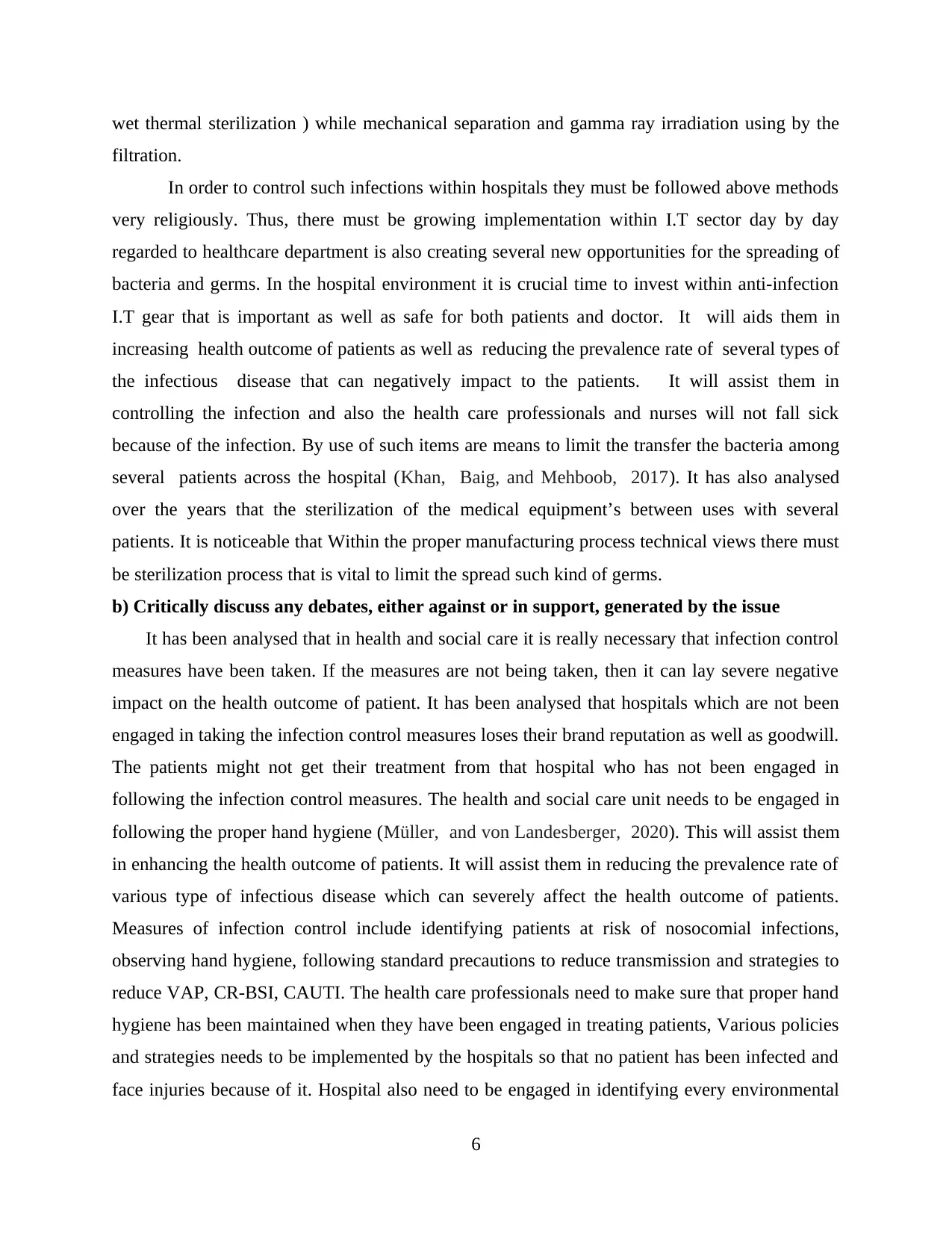
wet thermal sterilization ) while mechanical separation and gamma ray irradiation using by the
filtration.
In order to control such infections within hospitals they must be followed above methods
very religiously. Thus, there must be growing implementation within I.T sector day by day
regarded to healthcare department is also creating several new opportunities for the spreading of
bacteria and germs. In the hospital environment it is crucial time to invest within anti-infection
I.T gear that is important as well as safe for both patients and doctor. It will aids them in
increasing health outcome of patients as well as reducing the prevalence rate of several types of
the infectious disease that can negatively impact to the patients. It will assist them in
controlling the infection and also the health care professionals and nurses will not fall sick
because of the infection. By use of such items are means to limit the transfer the bacteria among
several patients across the hospital (Khan, Baig, and Mehboob, 2017). It has also analysed
over the years that the sterilization of the medical equipment’s between uses with several
patients. It is noticeable that Within the proper manufacturing process technical views there must
be sterilization process that is vital to limit the spread such kind of germs.
b) Critically discuss any debates, either against or in support, generated by the issue
It has been analysed that in health and social care it is really necessary that infection control
measures have been taken. If the measures are not being taken, then it can lay severe negative
impact on the health outcome of patient. It has been analysed that hospitals which are not been
engaged in taking the infection control measures loses their brand reputation as well as goodwill.
The patients might not get their treatment from that hospital who has not been engaged in
following the infection control measures. The health and social care unit needs to be engaged in
following the proper hand hygiene (Müller, and von Landesberger, 2020). This will assist them
in enhancing the health outcome of patients. It will assist them in reducing the prevalence rate of
various type of infectious disease which can severely affect the health outcome of patients.
Measures of infection control include identifying patients at risk of nosocomial infections,
observing hand hygiene, following standard precautions to reduce transmission and strategies to
reduce VAP, CR-BSI, CAUTI. The health care professionals need to make sure that proper hand
hygiene has been maintained when they have been engaged in treating patients, Various policies
and strategies needs to be implemented by the hospitals so that no patient has been infected and
face injuries because of it. Hospital also need to be engaged in identifying every environmental
6
filtration.
In order to control such infections within hospitals they must be followed above methods
very religiously. Thus, there must be growing implementation within I.T sector day by day
regarded to healthcare department is also creating several new opportunities for the spreading of
bacteria and germs. In the hospital environment it is crucial time to invest within anti-infection
I.T gear that is important as well as safe for both patients and doctor. It will aids them in
increasing health outcome of patients as well as reducing the prevalence rate of several types of
the infectious disease that can negatively impact to the patients. It will assist them in
controlling the infection and also the health care professionals and nurses will not fall sick
because of the infection. By use of such items are means to limit the transfer the bacteria among
several patients across the hospital (Khan, Baig, and Mehboob, 2017). It has also analysed
over the years that the sterilization of the medical equipment’s between uses with several
patients. It is noticeable that Within the proper manufacturing process technical views there must
be sterilization process that is vital to limit the spread such kind of germs.
b) Critically discuss any debates, either against or in support, generated by the issue
It has been analysed that in health and social care it is really necessary that infection control
measures have been taken. If the measures are not being taken, then it can lay severe negative
impact on the health outcome of patient. It has been analysed that hospitals which are not been
engaged in taking the infection control measures loses their brand reputation as well as goodwill.
The patients might not get their treatment from that hospital who has not been engaged in
following the infection control measures. The health and social care unit needs to be engaged in
following the proper hand hygiene (Müller, and von Landesberger, 2020). This will assist them
in enhancing the health outcome of patients. It will assist them in reducing the prevalence rate of
various type of infectious disease which can severely affect the health outcome of patients.
Measures of infection control include identifying patients at risk of nosocomial infections,
observing hand hygiene, following standard precautions to reduce transmission and strategies to
reduce VAP, CR-BSI, CAUTI. The health care professionals need to make sure that proper hand
hygiene has been maintained when they have been engaged in treating patients, Various policies
and strategies needs to be implemented by the hospitals so that no patient has been infected and
face injuries because of it. Hospital also need to be engaged in identifying every environmental
6
⊘ This is a preview!⊘
Do you want full access?
Subscribe today to unlock all pages.

Trusted by 1+ million students worldwide
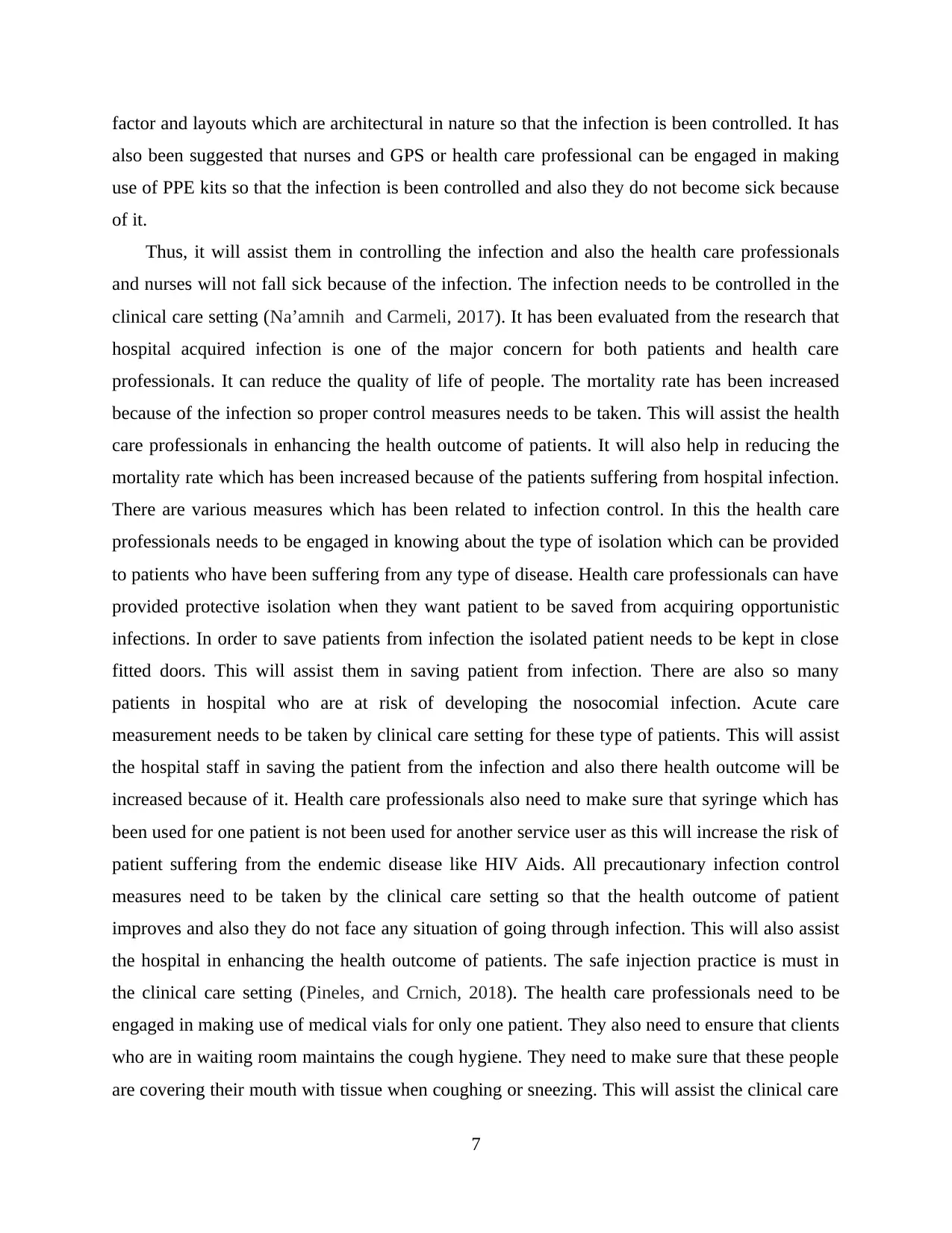
factor and layouts which are architectural in nature so that the infection is been controlled. It has
also been suggested that nurses and GPS or health care professional can be engaged in making
use of PPE kits so that the infection is been controlled and also they do not become sick because
of it.
Thus, it will assist them in controlling the infection and also the health care professionals
and nurses will not fall sick because of the infection. The infection needs to be controlled in the
clinical care setting (Na’amnih and Carmeli, 2017). It has been evaluated from the research that
hospital acquired infection is one of the major concern for both patients and health care
professionals. It can reduce the quality of life of people. The mortality rate has been increased
because of the infection so proper control measures needs to be taken. This will assist the health
care professionals in enhancing the health outcome of patients. It will also help in reducing the
mortality rate which has been increased because of the patients suffering from hospital infection.
There are various measures which has been related to infection control. In this the health care
professionals needs to be engaged in knowing about the type of isolation which can be provided
to patients who have been suffering from any type of disease. Health care professionals can have
provided protective isolation when they want patient to be saved from acquiring opportunistic
infections. In order to save patients from infection the isolated patient needs to be kept in close
fitted doors. This will assist them in saving patient from infection. There are also so many
patients in hospital who are at risk of developing the nosocomial infection. Acute care
measurement needs to be taken by clinical care setting for these type of patients. This will assist
the hospital staff in saving the patient from the infection and also there health outcome will be
increased because of it. Health care professionals also need to make sure that syringe which has
been used for one patient is not been used for another service user as this will increase the risk of
patient suffering from the endemic disease like HIV Aids. All precautionary infection control
measures need to be taken by the clinical care setting so that the health outcome of patient
improves and also they do not face any situation of going through infection. This will also assist
the hospital in enhancing the health outcome of patients. The safe injection practice is must in
the clinical care setting (Pineles, and Crnich, 2018). The health care professionals need to be
engaged in making use of medical vials for only one patient. They also need to ensure that clients
who are in waiting room maintains the cough hygiene. They need to make sure that these people
are covering their mouth with tissue when coughing or sneezing. This will assist the clinical care
7
also been suggested that nurses and GPS or health care professional can be engaged in making
use of PPE kits so that the infection is been controlled and also they do not become sick because
of it.
Thus, it will assist them in controlling the infection and also the health care professionals
and nurses will not fall sick because of the infection. The infection needs to be controlled in the
clinical care setting (Na’amnih and Carmeli, 2017). It has been evaluated from the research that
hospital acquired infection is one of the major concern for both patients and health care
professionals. It can reduce the quality of life of people. The mortality rate has been increased
because of the infection so proper control measures needs to be taken. This will assist the health
care professionals in enhancing the health outcome of patients. It will also help in reducing the
mortality rate which has been increased because of the patients suffering from hospital infection.
There are various measures which has been related to infection control. In this the health care
professionals needs to be engaged in knowing about the type of isolation which can be provided
to patients who have been suffering from any type of disease. Health care professionals can have
provided protective isolation when they want patient to be saved from acquiring opportunistic
infections. In order to save patients from infection the isolated patient needs to be kept in close
fitted doors. This will assist them in saving patient from infection. There are also so many
patients in hospital who are at risk of developing the nosocomial infection. Acute care
measurement needs to be taken by clinical care setting for these type of patients. This will assist
the hospital staff in saving the patient from the infection and also there health outcome will be
increased because of it. Health care professionals also need to make sure that syringe which has
been used for one patient is not been used for another service user as this will increase the risk of
patient suffering from the endemic disease like HIV Aids. All precautionary infection control
measures need to be taken by the clinical care setting so that the health outcome of patient
improves and also they do not face any situation of going through infection. This will also assist
the hospital in enhancing the health outcome of patients. The safe injection practice is must in
the clinical care setting (Pineles, and Crnich, 2018). The health care professionals need to be
engaged in making use of medical vials for only one patient. They also need to ensure that clients
who are in waiting room maintains the cough hygiene. They need to make sure that these people
are covering their mouth with tissue when coughing or sneezing. This will assist the clinical care
7
Paraphrase This Document
Need a fresh take? Get an instant paraphrase of this document with our AI Paraphraser
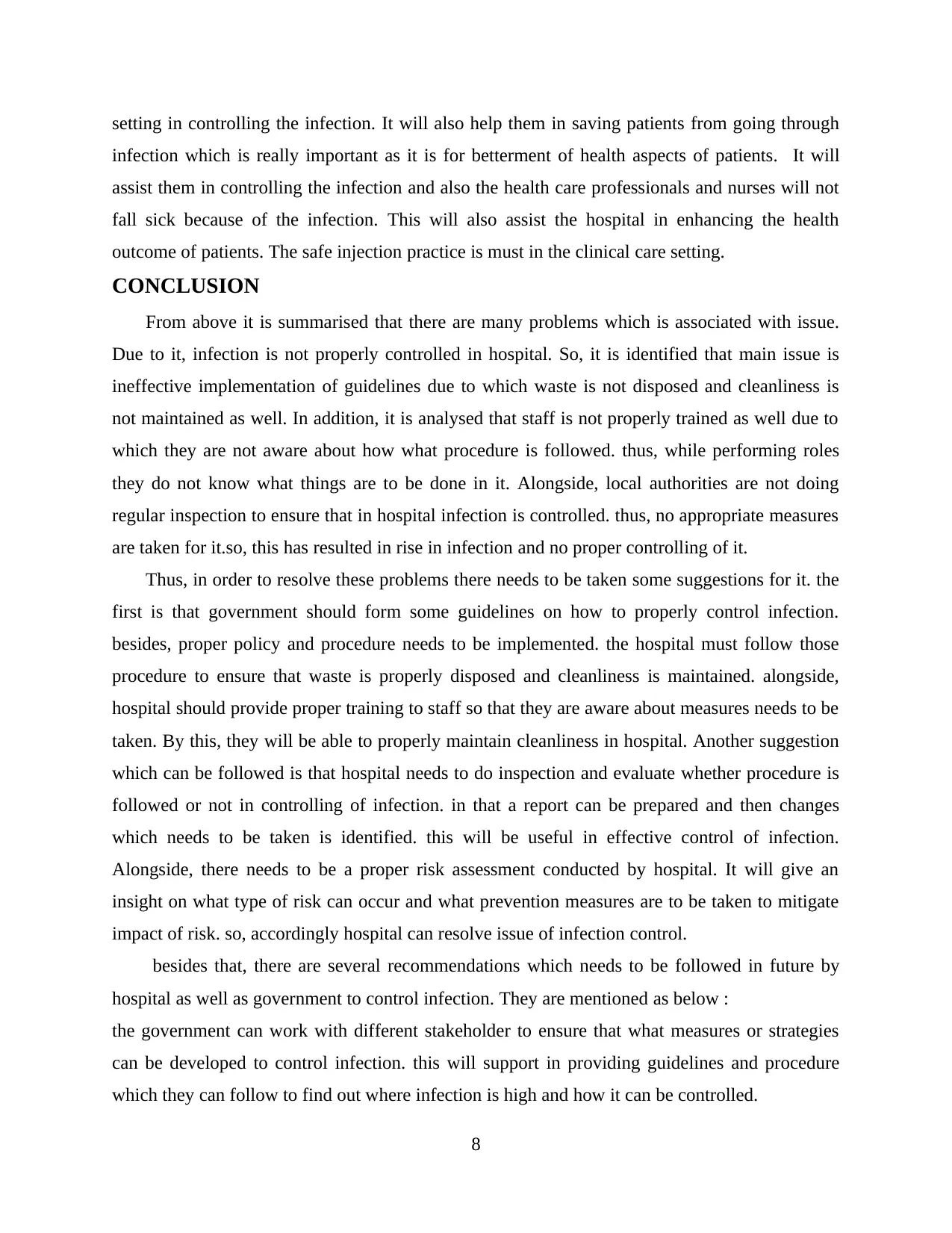
setting in controlling the infection. It will also help them in saving patients from going through
infection which is really important as it is for betterment of health aspects of patients. It will
assist them in controlling the infection and also the health care professionals and nurses will not
fall sick because of the infection. This will also assist the hospital in enhancing the health
outcome of patients. The safe injection practice is must in the clinical care setting.
CONCLUSION
From above it is summarised that there are many problems which is associated with issue.
Due to it, infection is not properly controlled in hospital. So, it is identified that main issue is
ineffective implementation of guidelines due to which waste is not disposed and cleanliness is
not maintained as well. In addition, it is analysed that staff is not properly trained as well due to
which they are not aware about how what procedure is followed. thus, while performing roles
they do not know what things are to be done in it. Alongside, local authorities are not doing
regular inspection to ensure that in hospital infection is controlled. thus, no appropriate measures
are taken for it.so, this has resulted in rise in infection and no proper controlling of it.
Thus, in order to resolve these problems there needs to be taken some suggestions for it. the
first is that government should form some guidelines on how to properly control infection.
besides, proper policy and procedure needs to be implemented. the hospital must follow those
procedure to ensure that waste is properly disposed and cleanliness is maintained. alongside,
hospital should provide proper training to staff so that they are aware about measures needs to be
taken. By this, they will be able to properly maintain cleanliness in hospital. Another suggestion
which can be followed is that hospital needs to do inspection and evaluate whether procedure is
followed or not in controlling of infection. in that a report can be prepared and then changes
which needs to be taken is identified. this will be useful in effective control of infection.
Alongside, there needs to be a proper risk assessment conducted by hospital. It will give an
insight on what type of risk can occur and what prevention measures are to be taken to mitigate
impact of risk. so, accordingly hospital can resolve issue of infection control.
besides that, there are several recommendations which needs to be followed in future by
hospital as well as government to control infection. They are mentioned as below :
the government can work with different stakeholder to ensure that what measures or strategies
can be developed to control infection. this will support in providing guidelines and procedure
which they can follow to find out where infection is high and how it can be controlled.
8
infection which is really important as it is for betterment of health aspects of patients. It will
assist them in controlling the infection and also the health care professionals and nurses will not
fall sick because of the infection. This will also assist the hospital in enhancing the health
outcome of patients. The safe injection practice is must in the clinical care setting.
CONCLUSION
From above it is summarised that there are many problems which is associated with issue.
Due to it, infection is not properly controlled in hospital. So, it is identified that main issue is
ineffective implementation of guidelines due to which waste is not disposed and cleanliness is
not maintained as well. In addition, it is analysed that staff is not properly trained as well due to
which they are not aware about how what procedure is followed. thus, while performing roles
they do not know what things are to be done in it. Alongside, local authorities are not doing
regular inspection to ensure that in hospital infection is controlled. thus, no appropriate measures
are taken for it.so, this has resulted in rise in infection and no proper controlling of it.
Thus, in order to resolve these problems there needs to be taken some suggestions for it. the
first is that government should form some guidelines on how to properly control infection.
besides, proper policy and procedure needs to be implemented. the hospital must follow those
procedure to ensure that waste is properly disposed and cleanliness is maintained. alongside,
hospital should provide proper training to staff so that they are aware about measures needs to be
taken. By this, they will be able to properly maintain cleanliness in hospital. Another suggestion
which can be followed is that hospital needs to do inspection and evaluate whether procedure is
followed or not in controlling of infection. in that a report can be prepared and then changes
which needs to be taken is identified. this will be useful in effective control of infection.
Alongside, there needs to be a proper risk assessment conducted by hospital. It will give an
insight on what type of risk can occur and what prevention measures are to be taken to mitigate
impact of risk. so, accordingly hospital can resolve issue of infection control.
besides that, there are several recommendations which needs to be followed in future by
hospital as well as government to control infection. They are mentioned as below :
the government can work with different stakeholder to ensure that what measures or strategies
can be developed to control infection. this will support in providing guidelines and procedure
which they can follow to find out where infection is high and how it can be controlled.
8
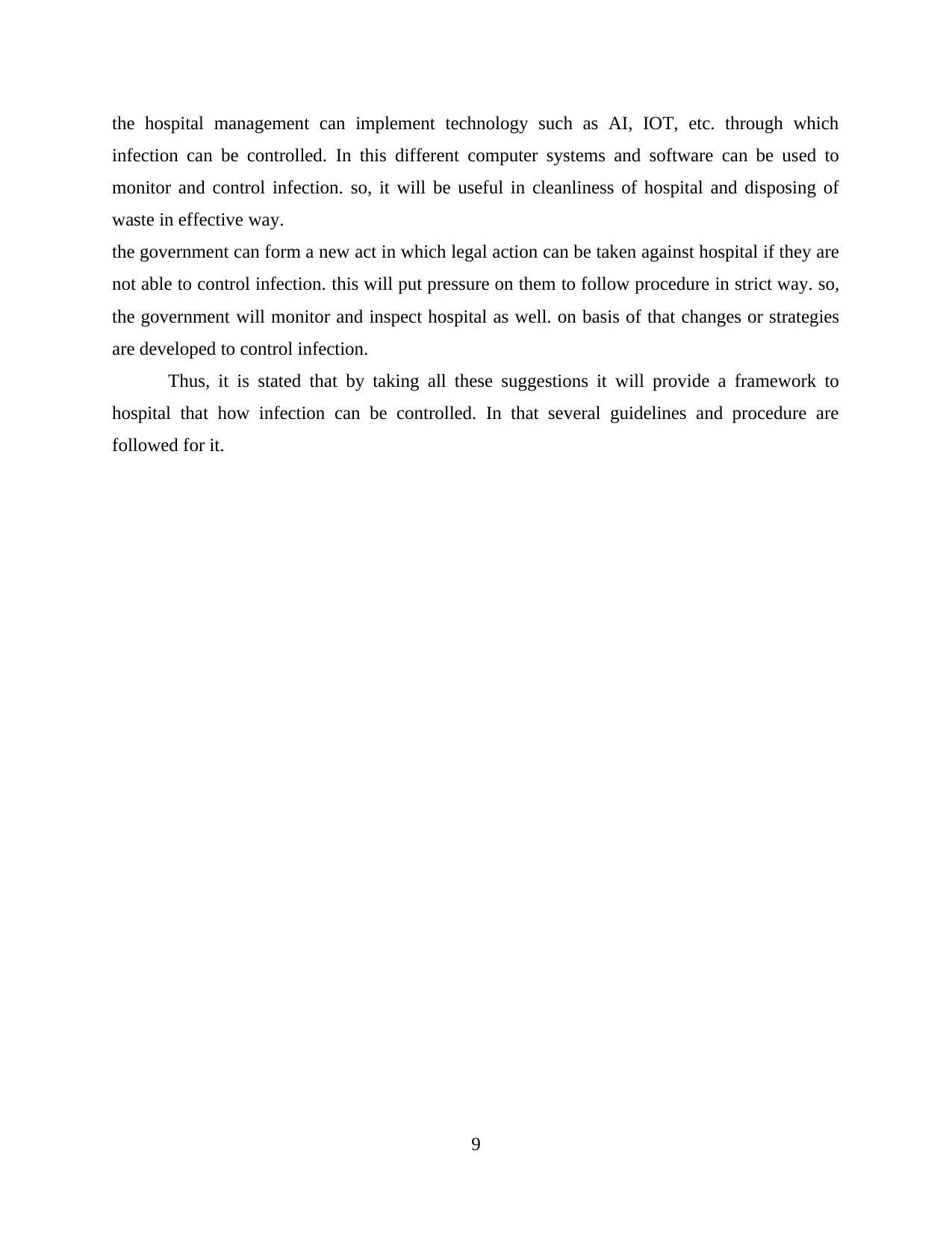
the hospital management can implement technology such as AI, IOT, etc. through which
infection can be controlled. In this different computer systems and software can be used to
monitor and control infection. so, it will be useful in cleanliness of hospital and disposing of
waste in effective way.
the government can form a new act in which legal action can be taken against hospital if they are
not able to control infection. this will put pressure on them to follow procedure in strict way. so,
the government will monitor and inspect hospital as well. on basis of that changes or strategies
are developed to control infection.
Thus, it is stated that by taking all these suggestions it will provide a framework to
hospital that how infection can be controlled. In that several guidelines and procedure are
followed for it.
9
infection can be controlled. In this different computer systems and software can be used to
monitor and control infection. so, it will be useful in cleanliness of hospital and disposing of
waste in effective way.
the government can form a new act in which legal action can be taken against hospital if they are
not able to control infection. this will put pressure on them to follow procedure in strict way. so,
the government will monitor and inspect hospital as well. on basis of that changes or strategies
are developed to control infection.
Thus, it is stated that by taking all these suggestions it will provide a framework to
hospital that how infection can be controlled. In that several guidelines and procedure are
followed for it.
9
⊘ This is a preview!⊘
Do you want full access?
Subscribe today to unlock all pages.

Trusted by 1+ million students worldwide
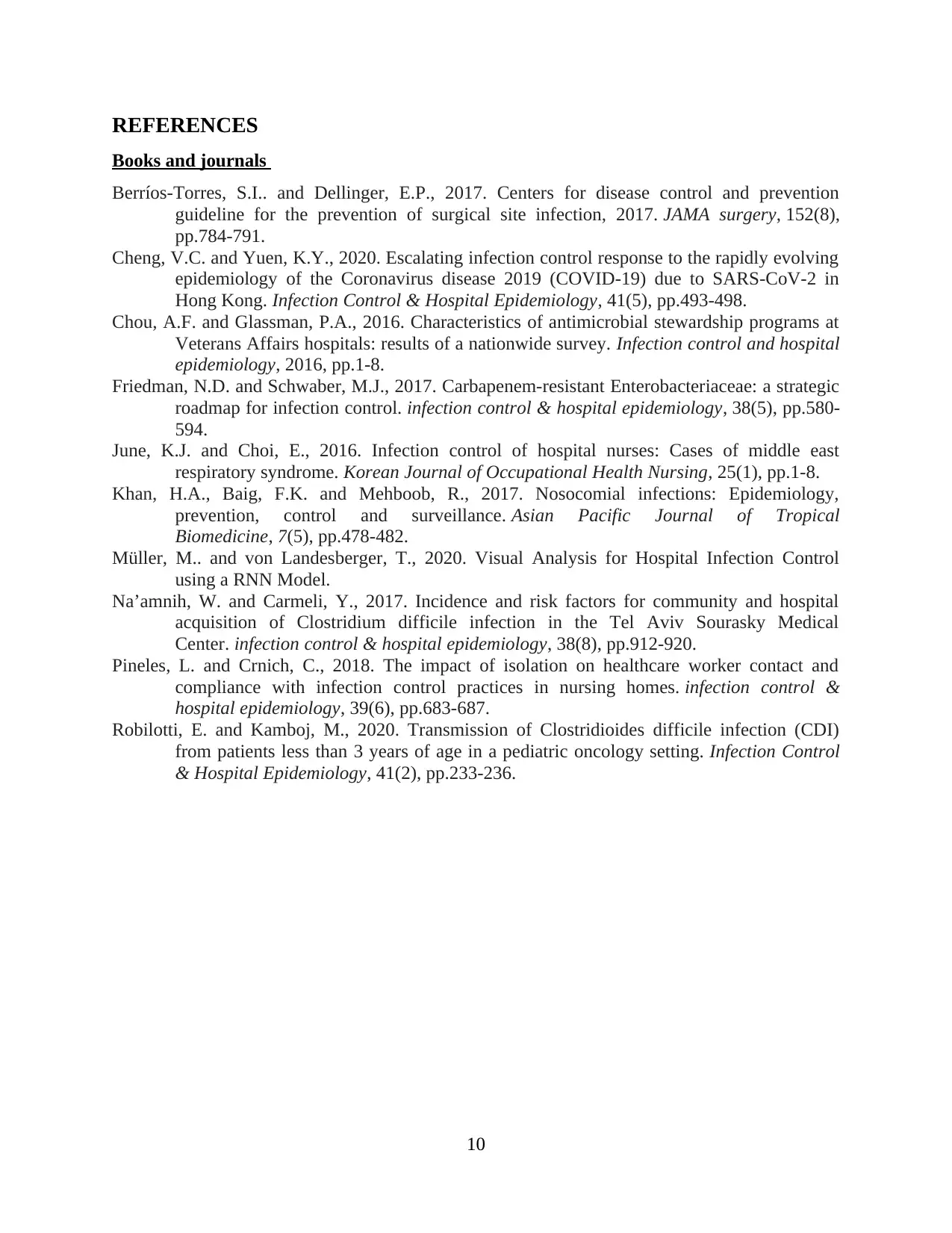
REFERENCES
Books and journals
Berríos-Torres, S.I.. and Dellinger, E.P., 2017. Centers for disease control and prevention
guideline for the prevention of surgical site infection, 2017. JAMA surgery, 152(8),
pp.784-791.
Cheng, V.C. and Yuen, K.Y., 2020. Escalating infection control response to the rapidly evolving
epidemiology of the Coronavirus disease 2019 (COVID-19) due to SARS-CoV-2 in
Hong Kong. Infection Control & Hospital Epidemiology, 41(5), pp.493-498.
Chou, A.F. and Glassman, P.A., 2016. Characteristics of antimicrobial stewardship programs at
Veterans Affairs hospitals: results of a nationwide survey. Infection control and hospital
epidemiology, 2016, pp.1-8.
Friedman, N.D. and Schwaber, M.J., 2017. Carbapenem-resistant Enterobacteriaceae: a strategic
roadmap for infection control. infection control & hospital epidemiology, 38(5), pp.580-
594.
June, K.J. and Choi, E., 2016. Infection control of hospital nurses: Cases of middle east
respiratory syndrome. Korean Journal of Occupational Health Nursing, 25(1), pp.1-8.
Khan, H.A., Baig, F.K. and Mehboob, R., 2017. Nosocomial infections: Epidemiology,
prevention, control and surveillance. Asian Pacific Journal of Tropical
Biomedicine, 7(5), pp.478-482.
Müller, M.. and von Landesberger, T., 2020. Visual Analysis for Hospital Infection Control
using a RNN Model.
Na’amnih, W. and Carmeli, Y., 2017. Incidence and risk factors for community and hospital
acquisition of Clostridium difficile infection in the Tel Aviv Sourasky Medical
Center. infection control & hospital epidemiology, 38(8), pp.912-920.
Pineles, L. and Crnich, C., 2018. The impact of isolation on healthcare worker contact and
compliance with infection control practices in nursing homes. infection control &
hospital epidemiology, 39(6), pp.683-687.
Robilotti, E. and Kamboj, M., 2020. Transmission of Clostridioides difficile infection (CDI)
from patients less than 3 years of age in a pediatric oncology setting. Infection Control
& Hospital Epidemiology, 41(2), pp.233-236.
10
Books and journals
Berríos-Torres, S.I.. and Dellinger, E.P., 2017. Centers for disease control and prevention
guideline for the prevention of surgical site infection, 2017. JAMA surgery, 152(8),
pp.784-791.
Cheng, V.C. and Yuen, K.Y., 2020. Escalating infection control response to the rapidly evolving
epidemiology of the Coronavirus disease 2019 (COVID-19) due to SARS-CoV-2 in
Hong Kong. Infection Control & Hospital Epidemiology, 41(5), pp.493-498.
Chou, A.F. and Glassman, P.A., 2016. Characteristics of antimicrobial stewardship programs at
Veterans Affairs hospitals: results of a nationwide survey. Infection control and hospital
epidemiology, 2016, pp.1-8.
Friedman, N.D. and Schwaber, M.J., 2017. Carbapenem-resistant Enterobacteriaceae: a strategic
roadmap for infection control. infection control & hospital epidemiology, 38(5), pp.580-
594.
June, K.J. and Choi, E., 2016. Infection control of hospital nurses: Cases of middle east
respiratory syndrome. Korean Journal of Occupational Health Nursing, 25(1), pp.1-8.
Khan, H.A., Baig, F.K. and Mehboob, R., 2017. Nosocomial infections: Epidemiology,
prevention, control and surveillance. Asian Pacific Journal of Tropical
Biomedicine, 7(5), pp.478-482.
Müller, M.. and von Landesberger, T., 2020. Visual Analysis for Hospital Infection Control
using a RNN Model.
Na’amnih, W. and Carmeli, Y., 2017. Incidence and risk factors for community and hospital
acquisition of Clostridium difficile infection in the Tel Aviv Sourasky Medical
Center. infection control & hospital epidemiology, 38(8), pp.912-920.
Pineles, L. and Crnich, C., 2018. The impact of isolation on healthcare worker contact and
compliance with infection control practices in nursing homes. infection control &
hospital epidemiology, 39(6), pp.683-687.
Robilotti, E. and Kamboj, M., 2020. Transmission of Clostridioides difficile infection (CDI)
from patients less than 3 years of age in a pediatric oncology setting. Infection Control
& Hospital Epidemiology, 41(2), pp.233-236.
10
1 out of 10
Related Documents
Your All-in-One AI-Powered Toolkit for Academic Success.
+13062052269
info@desklib.com
Available 24*7 on WhatsApp / Email
![[object Object]](/_next/static/media/star-bottom.7253800d.svg)
Unlock your academic potential
Copyright © 2020–2025 A2Z Services. All Rights Reserved. Developed and managed by ZUCOL.





